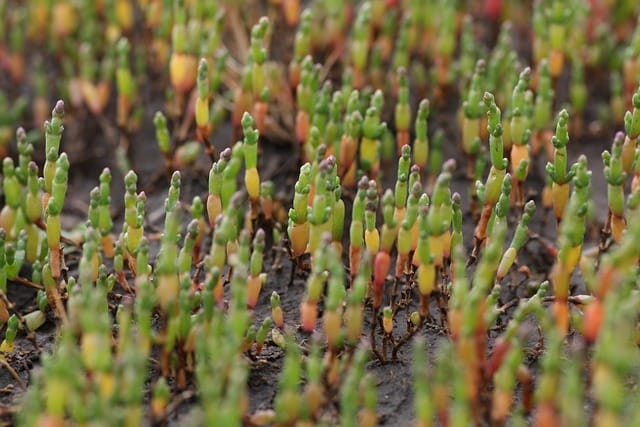How to grow Samphire
Samphire, also known as sea asparagus or glasswort, is a popular vegetable known for its salty and crunchy texture

In this article:
- Introduction to Samphires Vegetable
- Varieties of Samphires
- Growing Conditions for Samphires
- Choosing the Right Location
- Soil Preparation for Samphires
- Planting Samphires Seeds or Seedlings
- Watering and Irrigation
- Fertilizing Samphires
- Controlling Weeds and Pests
- Harvesting Samphires
- Storing and Preserving Samphires
- Common Problems and Solutions
- Culinary Uses of Samphires
- Conclusion and Final Tips
Introduction to Samphires Vegetable
Samphires, also known as sea asparagus or glasswort, are a popular vegetable known for their salty and crunchy texture. These vegetables thrive in coastal areas or marshlands as they grow naturally in salty environments. Rich in vitamins and minerals, samphires are not only nutritious but also a great addition to various dishes.
Varieties of Samphires
There are two main types of samphires: marsh samphire (Salicornia europaea) and rock samphire (Crithmum maritimum). Marsh samphire is the more common variety found in most regions, while rock samphire is a bit harder to find and often grows in rocky coastal regions.
Growing Conditions for Samphires
Samphires require a sunny and sheltered location with ample airflow. They prefer growing in areas with high salinity, sandy soil, and a mild climate. The ideal temperature range for samphires is 15-25°C (59-77°F).
Choosing the Right Location
Select a location close to the coast or an area with high salinity. Ensure the spot receives at least six hours of direct sunlight daily. Avoid areas with excessive shade or competition from other plants.
Soil Preparation for Samphires
Prepare the soil by removing any weeds, rocks, or debris. Samphires prefer sandy soils with good drainage. You can improve the soil quality by adding organic matter or compost to provide essential nutrients.
Planting Samphires Seeds or Seedlings
Samphires can be grown from both seeds and seedlings. If you choose to sow seeds, start them indoors in trays with a well-draining potting mix. Once they develop a few true leaves, transplant them into the prepared soil. Alternatively, you can directly sow the seeds into the ground after the last frost date. For seedlings, gently transplant them into the soil, ensuring you don't disrupt their delicate roots.
Watering and Irrigation
Samphires have moderate water needs. Water the plants regularly, ensuring the soil remains moist but not waterlogged. Consider using a drip irrigation system to provide consistent moisture levels. Avoid overhead watering as it can lead to fungal diseases.
Fertilizing Samphires
Samphires do not require heavy fertilization. However, you can apply a balanced organic fertilizer once every few weeks during the growing season. Be cautious not to over-fertilize, as it may lead to excessive leafy growth.
Controlling Weeds and Pests
Keep a close eye on weeds and remove them regularly to prevent competition for nutrients and space. In terms of pests, samphires are relatively resistant. However, occasional pests like aphids, slugs, or snails might attack the plants. Use organic insecticides or natural pest control methods to manage them effectively.
Harvesting Samphires
Harvest samphires when they reach a height of 10-15cm (4-6 inches). Cut the stems using a sharp knife, leaving a few inches above the ground to ensure regrowth. Harvesting can typically be done from late spring until early fall.
Storing and Preserving Samphires
For immediate use, rinse the harvested samphires with fresh water to remove excess salt. Store them in the refrigerator wrapped in a damp paper towel or in a plastic bag. They can remain fresh for up to a week.
Common Problems and Solutions
Some common problems that may arise while growing samphires include fungal diseases, such as powdery mildew or root rot. Ensure proper airflow around the plants and avoid overwatering. If fungal infections occur, treat them with appropriate organic fungicides.
Culinary Uses of Samphires
Samphires are a versatile ingredient that can be used in various culinary applications. They can be enjoyed raw in salads, pickled, steamed, stir-fried, or blanched. They add a unique salty and crunchy flavor to seafood dishes, pasta, or even as a garnish.
Conclusion and Final Tips
Growing samphires can be a rewarding experience. Remember to choose the right location with sufficient sunlight and high salinity. Prepare the soil adequately and provide regular watering and minimal fertilization. Control weeds and pests promptly, and harvest at the right time. With proper care, you can enjoy a continuous supply of fresh and flavorful samphires throughout the growing season.
